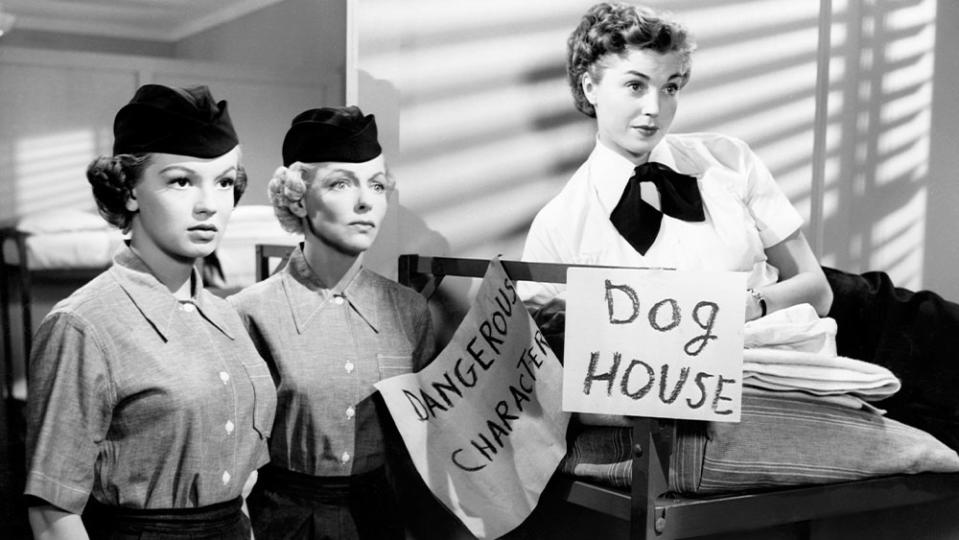Joan Evans, Actress in ‘On the Loose,’ ‘Skirts Ahoy!’ and ‘Edge of Doom,’ Dies at 89

Joan Evans, the daughter of screenwriters and goddaughter of Joan Crawford, who starred opposite Farley Granger in her first three films and with Audie Murphy in a pair of Westerns, has died. She was 89.
Evans died Oct. 21 in Henderson, Nevada, her son, John Weatherly, told The Hollywood Reporter.
More from The Hollywood Reporter
She also toplined the Charles Lederer-directed On the Loose (1951), playing a suicidal teenager in the drama written by her parents, Dale Eunson and Katherine Albert; portrayed Irene Dunne’s daughter in the fantasy It Grows on Trees (1952); and enlisted in the U.S. Navy with Esther Williams in the musical comedy Skirts Ahoy! (1952).
Evans played the love interest of Granger’s character in the title role of Roseanna McCoy (1949), a drama loosely based on the family feud between the Hatfields and the McCoys. The two worked together again in the 1950 releases Our Very Own and Edge of Doom, a bleak film noir directed by Mark Robson.
The actress later starred with Murphy in Column South (1953), helmed by future Tonight Show director Fred De Cordova, and No Name on the Bullet (1959), helmed by Jack Arnold.

Named for Crawford, Joan Katherine Eunson was born on July 18, 1934, in New York. Her mom had begun her career as a Hollywood journalist and publicist at MGM, where Crawford first found fame, and she would go on to write many articles about the actress while at Photoplay magazine.
“They were best friends,” Evans noted in an entertaining interview with Foster Hirsch in 2013.
Evans had been on the stage but was only 14 when she went to work on Roseanna McCoy for producer Samuel Goldwyn. He had signed her to a contract in 1948 and put her in the movie after firing Cathy O’Donnell, who had married the brother of William Wyler, who left Goldwyn to launch his own production company.
While director Nicholas Ray was doing reshoots on the film, Evans was “accidentally shot very, very seriously” in the arm by Granger when a gun he was carrying discharged in the hills outside Columbia, California, she told Hirsch. She needed emergency surgery and was hospitalized.

Days after she had turned 18, Evans and her boyfriend, car dealer Kirby Weatherly, then 26, were invited to Crawford’s Brentwood home for dinner, and after their meal, the Mildred Pierce star decided that the couple should get married — that night. Crawford called a judge over to perform the ceremony, and Evans and Weatherly were wed minutes after midnight on July 24, 1952.
“The head of publicity at Goldwyn had said to me, ‘Joan, I don’t care what you do, just don’t call me in the middle of the night and tell me you’re married,’” she said. “So, I called him in the middle of the night and told him I was married.”
Her parents did not want this to happen and were furious with Crawford, never to speak with her again.
Some speculate that Crawford went against Eunson and Albert’s wishes because they had recently written the screenplay for The Star (1952), which featured Bette Davis in an Oscar-winning turn as an aging, washed-up actress desperate to reignite her career. Davis said she based the character on her bitter rival, Crawford.
Evans and Weatherly were together until his death on Jan. 1. Their marriage “wasn’t the mistake that my parents foretold,” she said.
Meanwhile, she remained close with Crawford until her 1977 death and said she never witnessed any evidence of “Mommie Dearest” behavior from her.
“I saw a wonderful, darling friend who was generous to the max to everyone, certainly to me,” she told Hirsch. “When I was a little girl, I traveled on the train from New York to California with Joan; now that would bring out the worst in any great actress, [and it didn’t].”
Evans also appeared in such other films as The Outcast (1954), A Strange Adventure (1956), The Flying Fontaines (1959) and The Walking Target (1960), and on TV shows including Climax!, The Millionaire, Cheyenne, 77 Sunset Strip, Wagon Train, Zorro, Tales of Wells Fargo, The Tall Man and Laramie.
She stepped aside from acting in the early ’60s to care for her family and later was an editor of Hollywood Studio Magazine and a teacher at the Carden Academy in Van Nuys.
All along, her parents, who were also playwrights and novelists, kept writing, with their credits including All Mine to Give (1957), Gidget Goes to Rome (1963) and several episodes of Leave It to Beaver.
In addition to her son, survivors include her daughter, Dale, and a grandson, Chris.
Best of The Hollywood Reporter
